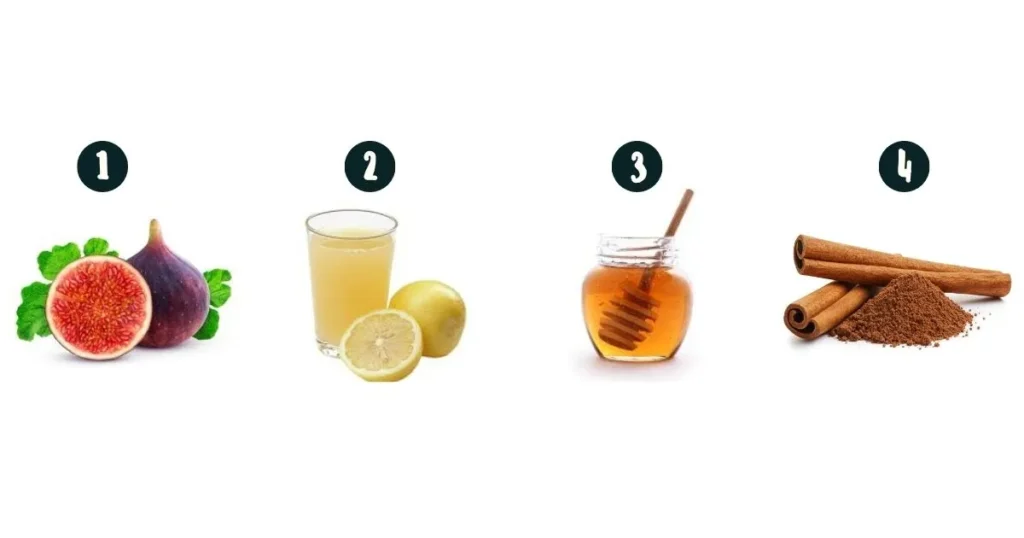This fig jam recipe is made with ripe figs, honey, warm cinnamon spice, and a splash of lemon juice. A delicate and easy way to preserve the fresh autumn harvest before it spoils. There is no need for pectin, refined sugar, or canning fuss. It’s perfect for holiday breakfasts, toast, yogurt bowls, sandwiches, and charcuterie boards. No wonder everyone loves it!
Fun Fact
Figs and olives are the first fruits cultivated on earth and are 80 million years old. So, every time you eat one, remember:
Table of Contents
“Every fig is a story, a history”
It’s a kind of family tradition to visit the farms every fall and celebrate the autumn harvest in North Carolina. My Uncle Patrick is an Orchardist who loves to take care of every inch of our orchard. Everyone knows if you can’t find him, just follow the smell of figs and apples drifting through the air. Like every year, we pick some baskets of figs and apples from his orchard. Keeping the fall tradition, almost all the apples are utilized in making apple pies and crisp Pop-Tarts. However, half of the figs disappeared into Uncle Patrick’s stomach (Just kidding). The remaining figs are enough to make several batches of fig jams. One of our favorite ways to enjoy the delicious jam throughout the “BER” months!
I tend to avoid processed, sugar-laden spreads because they feel like eating syrupy jam. Refined sugar masks the natural sweetness of figs. Figs have a lot of natural sugar. A medium fig has about 8g of sugar. Although I love the sweet fig jam, I asked my uncle, “If there is a way I can cut down the refined sugar without losing sweetness?” He chuckled, saying, “why not try something natural, sweetener and spices that remind you of the Fall?”. I immediately blurted out, “Honey and cinnamon.” Uncle Patrick nodded in approval. I was relieved!
Types Of Figs Best for Jam
The best fruit to choose for jam is ripe, sweet, and juicy, and it beautifully melts to form a smooth jam. I think Black Mission figs, brown turkey figs, and black Madeira are my top choices. However, it’s not a hard and fast rule to choose the specific fig variety. It depends on what you have on hand. It’s a common misconception that dark purple figs are sweeter than green ones. The sweetness comes from the genes and variety of figs, not their skin color. There are several varieties of figs that I find best suited for making jam.
- Black Mission Figs: These dark purple to black colored figs have pink flesh and a sweet, berry-like taste. They are most common in grocery stores and farmers’ markets in September as they are a mid-season variety. They ripen to perfection without becoming mushy.
- Black Madeira: It arrives in late October and boasts an excellent, berry-like taste with a high level of sweetness. The dark skin color and dark red flesh make it significant among all others. Uncle always says it is a natural jam inside the fruit.
- Brown Turkey Figs: It is not as intense as the Black Mission and Black Madeira, but it is perfect for those with a milder flavor preference than these two. It pairs well with honey and warm cinnamon spices due to its less-sweet and light flavor.
- Alma: It is a juicy and sweet variety characterized by its brown skin and brown flesh. It is best for jam, but the color of the jam is lighter than that of black mission. Mix some black mission with them for a perfect balance of color and flavor.
- Kadota: These yellow-green and amber-colored-fleshed varieties of figs have sweet and honey-like flavors. Warm spices enhance their taste in jams and preserves.
- Calimyrna Figs: It’s another variety good for jams due to its slightly nutty and sweet, earthy flavor. Many describe their taste as melon-like. However, many use them to dry, pair with cheese, or for baking purposes.
Difference Between Preserve and Jam
The only difference between preserves and jams is the size of the fruit. Preserves have whole fruit or large fruit pieces, making them chunkier and more spoonful. Jam, on the other hand, has a lumpy, crushed, mashed, or pureed fruit, making it smoother and spreadable.
Equipment
- A large surface area non-stick saucepan
- Potato masher, blender, or food processor
Ingredients
- 500g fresh figs, 14-16 medium chopped or quartered black mission figs
- 2 tablespoons of lemon juice, seeds excluded
- 1 cup of water
- ¼ cup honey
- ¼ tsp cinnamon powder
Ingredients
- Figs: Take 500g (approx.14-16 medium figs) ripe black mission or any variety of figs which are soft but not too mushy. If the figs you’ve got are a little mushy, put them in the fridge for 20 minutes before chopping them so they become firm enough to get chopped.
- Honey: After Uncle’s approval, I cut down the refined sugar and used a ¼ cup of honey. It enhances the sweetness of jam plus keeps it preserved for some months. There is one more secret of this jam, the honey! Based on my personal experience, wildflower honey gives you the best classic flavor. But in case of jam for the holiday table, Uncle Patrick uses Lavender Honey, and that makes me want to slurp the whole jam.
- Lemon Juice: The citrus in the form of lemon juice helps lower the PH (increasing the acidic content) of jam, preventing the growth of bacteria and other microorganisms, and slowing the spoilage of jam. Yes, since we are not using pectin, lemon juice enhances the activity of natural pectin in fruit, making it thicker. In general, you can substitute orange juice with lemon juice to achieve the citrus flavor.
- Cinnamon: I personally prefer the powdered cinnamon in jam because I enjoy the warm, infused flavor. However, use a whole cinnamon stick while simmering the jam, and once the jam is ready, remove the stick.
- Water: A cup of room-temperature water to soften the figs without burning and sticking them to the pan.
Instructions
1.Clean and Chop
Wash the ripe figs to remove the debris or any dirt. Cut the pointy, hard stem. Quarter them or roughly chop them, depending on the size of the figs.
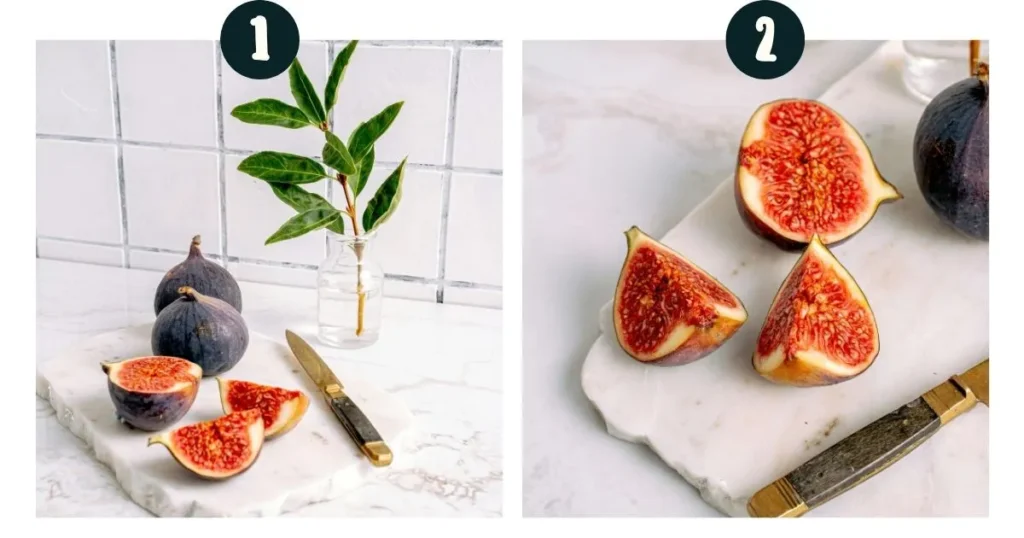
Tip
- There is no need to peel the skin off, as it melts as it simmers, adding depth of color and flavor.
- The chopping size will decide the final texture of your jam. If you prefer a little chunkier than quarter them, otherwise roughly chop them.
2.Combine and Macerate
In a large, 7-quart nonstick saucepan, combine the quartered figs, honey, and water. Mix and cook all the ingredients on medium heat for 10 minutes, or until the figs have softened and broken down into a soft, runny pulp.
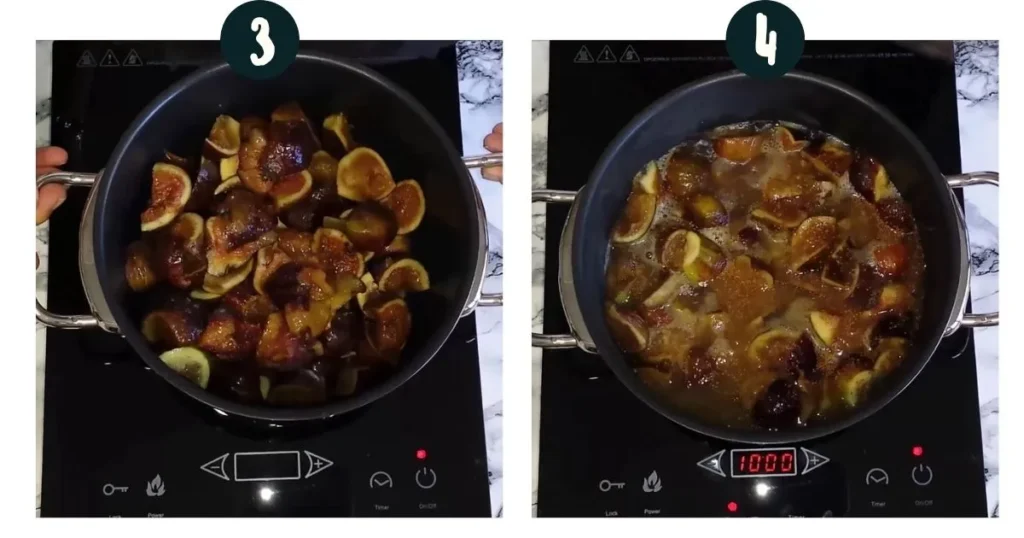
Tip
Cover the pan with a lid while macerating the figs to prevent condensation from letting the water escape, making the figs soft in their own juices. Figs also release their juices in this step.
3.Mash the Jam
Once they are softened, uncover and mash with the help of a potato masher. If you are like Uncle Patrick, who dislikes lumpy jam, just make it smooth and puree-like consistency by blending it.
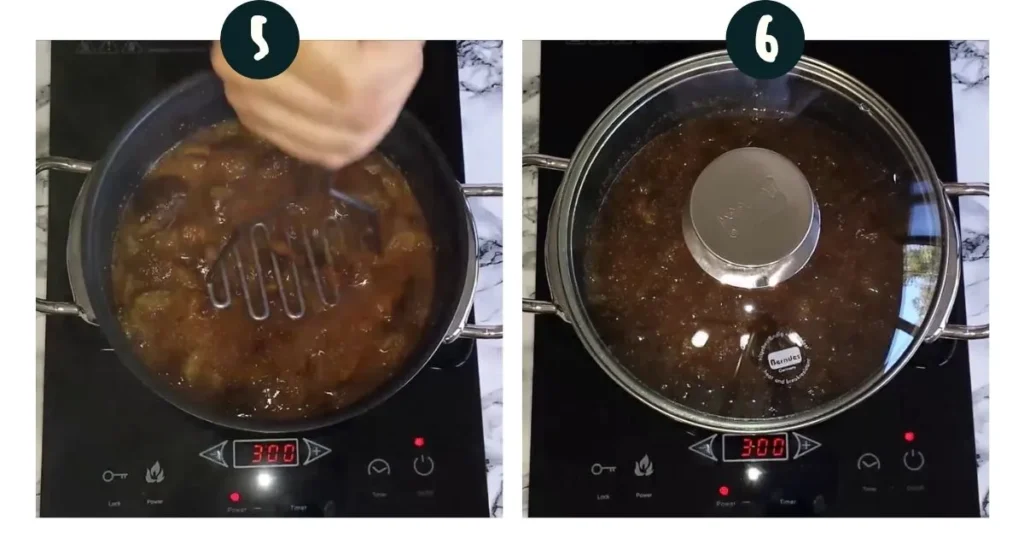
4.Simmer Until Jammy
Incorporate lemon juice and cinnamon, and let all simmer on low heat, uncovered, for about 35-40 minutes or until the desired jammy consistency is achieved. Stir the jam mixture occasionally to avoid burning.
Tip
Keep it a little runnier (while it is still hot) than the perfect jam consistency, because the mixture thickens as it cools.
5.Plate Test to Determine if the Jam is Ready
To check if your jam is ready, simply conduct a quick test. Pour a small amount of jam on a plate and put it in the fridge for 10-15 minutes. If the jam is thick, firm, drops, and moves slowly, it means it is ready. If it is runny and moves quickly like a syrup, it is not cooked and needs to be cooked for a few minutes until it sets. If it is sticky, rubbery, or not moving, it is overcooked. To fix the overcooked jam, reheat it by adding water or orange juice until it matches the desired consistency.
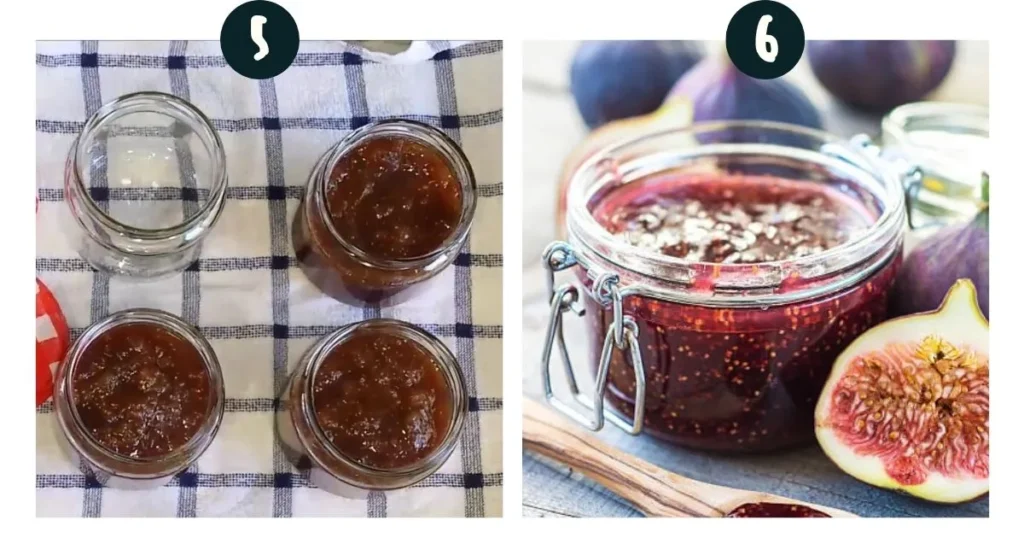
6.Cool, Store, and Enjoy
Cool the jam and fill it into a half-pint jar (8-ounce jar), leaving a ¼-inch space in the jar to allow it to expand and create a vacuum seal. Store the jar in the refrigerator for 3 months. Enjoy the jam on toast, in sandwiches, on cheese, in desserts, on ice cream, or any other way you can think of to enjoy it.
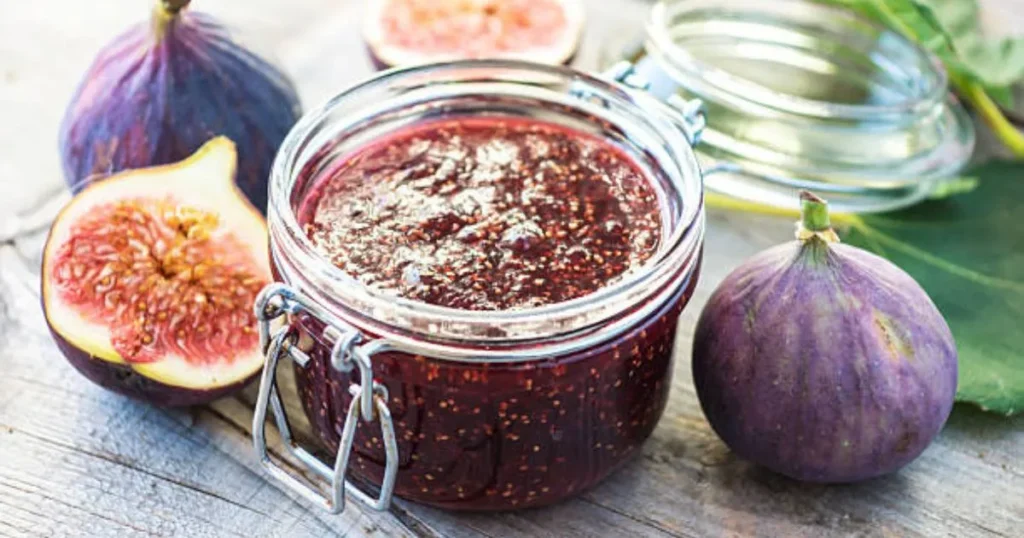
Optional Additions
- More Warm Spices: If you want it to smell like fall jam, try star anise, nutmeg, cardamom, or rosemary sprig and see what magic they create!
- Fiery kick: Try adding hot chili pepper, Jalapeno, or Habanero peppers in small quantities for a contrasting sweet-spicy flavor. Start with less and adjust accordingly.
- Chocolate feel: Although my uncle is not a chocolate ghost, I am. That’s why I made a few batches of chocolate-flavored fig jam by adding a tablespoon of cocoa or dark cocoa powder. The chocolate flavor is the most unique variation of this jam recipe.
- Other Extraordinary additions: Ginger, balsamic vinegar, or a few drops of vanilla to enhance the flavors.
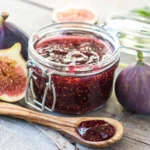
Easy Fig Jam Recipe Made With Figs, Lemon, And Love!
- Total Time: 1 hour
Description
This fig jam recipe is made with ripe figs, honey, warm cinnamon spice, and a splash of lemon juice. A delicate and easy way to preserve the fresh autumn harvest before it spoils. There is no need for pectin, refined sugar, or canning fuss. It’s perfect for holiday breakfasts, toast, yogurt bowls, sandwiches, and charcuterie boards. No wonder everyone loves it!
Ingredients
- 500g fresh figs, 14-16 medium chopped or quartered black mission figs
- 2 tablespoons of lemon juice, seeds excluded
- 1 cup of water
- ¼ cup honey
- ¼ tsp cinnamon powder
Instructions
- Clean and Chop: Wash the ripe figs to remove the debris or any dirt. Cut the pointy, hard stem. Quarter them or roughly chop them, depending on the size of the figs.
- Tip: There is no need to peel the skin off, as it melts as it simmers, adding depth of color and flavor.
- The chopping size will decide the final texture of your jam. If you prefer a little chunkier than quarter them, otherwise roughly chop them.
- Combine and Macerate: In a large, 7-quart nonstick saucepan, combine the quartered figs, honey, and water. Mix and cook all the ingredients on medium heat for 10 minutes, or until the figs have softened and broken down into a soft, runny pulp.
- Tip: Cover the pan with a lid while macerating the figs to prevent condensation from letting the water escape, making the figs soft in their own juices. Figs also release their juices in this step.
- Mash the jam: Once they are softened, uncover and mash with the help of a potato masher. If you are like Uncle Patrick, who dislikes lumpy jam, just make it smooth and puree-like consistency by blending it.
- Simmer until jammy: Incorporate lemon juice and cinnamon, and let all simmer on low heat, uncovered, for about 35-40 minutes or until the desired jammy consistency is achieved. Stir the jam mixture occasionally to avoid burning.
- Tip: Keep it a little runnier (while it is still hot) than the perfect jam consistency, because the mixture thickens as it cools.
- Plate Test to Determine if the Jam is Ready: To check if your jam is ready, simply conduct a quick test. Pour a small amount of jam on a plate and put it in the fridge for 10-15 minutes. If the jam is thick, firm, drops, and moves slowly, it means it is ready. If it is runny and moves quickly like a syrup, it is not cooked and needs to be cooked for a few minutes until it sets. If it is sticky, rubbery, or not moving, it is overcooked. To fix the overcooked jam, reheat it by adding water or orange juice until it matches the desired consistency.
- Cool, Store, and Enjoy: Cool the jam and fill it into a half-pint jar (8-ounce jar), leaving a ¼-inch space in the jar to allow it to expand and create a vacuum seal. Store the jar in the refrigerator for 3 months. Enjoy the jam on toast, in sandwiches, on cheese, in desserts, on ice cream, or any other way you can think of to enjoy it.
- Prep Time: 10 minutes
- Cook Time: 50 minutes
- Category: jams, dessert
FAQ’s For This Fig Jam Recipe
Do you peel the figs for fig jam?
I wouldn’t recommend peeling the fig’s skin because once it starts cooking, the skin dissolves and makes the taste even better. Fig skin, on the other hand, adds texture, flavor, and extra nutrients to jam. If you are fine with peeling the skin, just do it!
What’s the difference between fig jam and fig preserves?
The only difference between fig preserves and fig jam is the size of the fruit. Fig preserves have whole fruit or big fruit pieces, making it chunkier and spoonful. Jam, on the other hand, has a lumpy, crushed, mashed, or pureed fruit, making it smoother and spreadable.
Is fig jam good for health?
I will always choose homemade fig jam rather than commercial jams, which are heavily processed. Freshly made fig jam is rich in antioxidants, fiber, and minerals, and it does not contain any additives.


